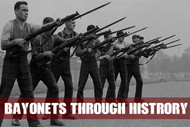Different Types of Bayonets Through the Ages
Posted by SwordsSwords on Sep 15th 2023
As nations evolve, so do their means of battle and weapons. The weaponry of age and a nation reflects the wielder of the weapon. Bayonets have been the weapons of choice for militaries around the globe ever since the firearms were invented.
It can be termed as man’s love for a sharp blade before that of firearms. These daggers mounted on or in the barrel of the gun has the potential for quite some damage in close combat situations.
These are many different types of knives, specifically based on their position on the gun as well as their point of origin.
Every time period and geographical zone had their own interpretation. These types are explained below.
1.Plug Bayonets
Originated in the early 1600s in China, the plug bayonet is called as such for its ability to be plugged inside the barrel of the gun.
It is particularly useful in instances when gunpowder and other ballistic ammunition has depleted in a firefight. The blade and the gun combined to make a spear-like weapon that can be used to fend off enemies in close-quarter combat.
However, this can only be used if there is no opportunity for reloading ammunition. This is because plugging it in and out repeatedly could be a deadly chore.
2.Socket Bayonets
Socket bayonets are the products of the 1690s as the plug variants caused the loss of many battles back then.
Soldiers would lose precious time in attaching the blades while the enemy was free to take advantage of the lag in the offense. These guns had a special blade socket under or over the barrel. This allowed the soldier to fire and reload the gun while using the pointed blade.
3.Sword Bayonets
This was the first double edged blade variation in history. The sword was attached under the barrel and could be used not only as a blocking and stabbing armament but also for slashing and maiming. This concept was introduced in the early 1800s. However, these ran out of vogue in the 1850s.
4.Knife Bayonets
Knife bayonets are a type of knife characterized by its similarity to traditional knife. These bayonets typically have a narrow, sharp point and a hilt that allows for a secure grip. They were widely used in the 19th and early 20th centuries and were favored by soldiers for their utility both as a weapon and a tool.
5.Spike Bayonets
Spike bayonets, as the name suggests, feature a long pointed blade blade. These bayonets were designed primarily for thrusting and were simple and cost-effective to produce. While lacking the cutting edge of other bayonets, spike bayonets were still deadly in the hands of a skilled soldier.
6.Trench Bayonets
Trench warfare during World War I led to the development of specialized trench bayonets. These bayonets were designed to be effective in close combat, where traditional long rifles and bayonets were unwieldy. Trench bayonets often had shorter blades and unique shapes, allowing soldiers to navigate the narrow confines of trenches more efficiently.
7.Modern Tactical Bayonets
In contemporary times, bayonets have evolved to meet the needs of modern military and law enforcement. Modern tactical bayonets often feature high-quality materials, ergonomic grips, and specialized knife blade coatings for increased durability and effectiveness. These bayonets are designed to attach to rifles and are used for various tactical purposes.
8.M9 Bayonet:
The M9 bayonet was introduced in the 1980s to replace older M6 and M7 bayonets. It fits both the M16A1/A2 rifles as well as the M4 carbine when used with an adapter.
The M9 has a fixed blade made of tough 1095 carbon steel. It measures 10.5 inches in overall length and features a triangular blade shape with a single cutting edge.
This design makes it effective for stabbing in close quarters combat situations. However, the M9 bayonet can also serve as a general purpose survival/utility knife for tasks like cutting when detached from the rifle.
9.M7 Bayonet:
The M7 bayonet preceded the M9 and was first introduced in the 1950s for use on the M14 rifle and other battle rifles of its era. It also has a fixed blade, made from 1085 carbon steel, measuring 11.5 inches long.
In contrast to the M9, the bayonet M7 blade has a clip point shape with both a pointed tip and a full cutting edge suitable for slashing. It also features a blood groove or fuller on the blade to help control the path of the cut.
In addition to stabbing, this design allowed the M7 to be used for slashing techniques. It remained in service alongside the later M9 bayonet until being fully replaced as the M14 was phased out in the 1990s and newer rifles entered widespread use.
Check out the 5 deadliest knives and daggers ever made in human history! The last one will surprise you!

